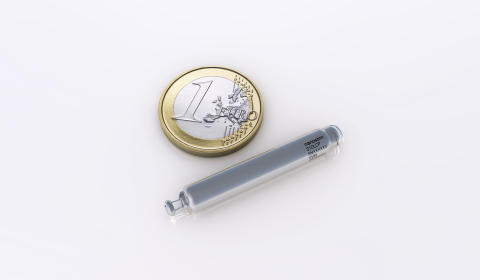St. Jude Medical, Inc. (NYSE:STJ), a global medical device company, today announced CE Mark approval for magnetic resonance (MR) conditional labeling for 1.5 T scans for the company’s Nanostim™ leadless pacemaker. With the approval, throughout Europe both existing patients implanted with a Nanostim leadless pacemaker and new patients receiving a Nanostim leadless pacemaker in the future can safely undergo full-body MRI diagnostic scans.
This Smart News Release features multimedia. View the full release here: http://www.businesswire.com/news/home/20160310005192/en/

The world's first commercially available retrievable leadless pacemaker, St. Jude Medical's Nanostim™ leadless pacemaker is now MRI Ready, allowing existing and future patients in Europe with this technology to undergo full body MRI scans. (Photo: Business Wire)
The latest approval builds upon the company's portfolio of MRI compatible products, and furthers patient access to the technological benefits of the Nanostim leadless pacemaker, the world’s first commercially available retrievable leadless pacemaker.
“Providing my patients access to a highly advanced pacemaker that can undergo an MRI scan is a notable step forward in treatment options,” said Dr. Johannes Sperzel, head of the electrophysiology department at the Kerckhoff Klinik in Bad Nauheim, Germany.
Dr. Tom Wong, cardiologist and electrophysiologist at Royal Brompton Hospital in London, adds, “It’s important that my patients in need of pacemakers also have the freedom to undergo MRI diagnostic scans for other conditions, if needed. This new labeling provides that flexibility and will be of great benefit to patients to ensure peace of mind for the future.”
More than 4 million people worldwide have an implanted pacemaker or other cardiac rhythm management device, and an additional 700,000 patients receive the devices each year. The Nanostim leadless pacemaker is less than 10 percent the size of a conventional pacemaker and designed to be implanted directly in the heart without the need for a surgical pocket or lead. The elimination of the visible lump and scar at a conventional pacemaker’s implant site, in addition to the removal of patient activity restrictions that may prevent the dislodgement or damage to a conventional lead, will potentially improve the quality of life for patients with this technology by allowing most to continue living active, uninhibited lifestyles.
“The Nanostim leadless pacemaker is one of the most important advances in the history of pacemaker technology,” said Dr. Mark Carlson, vice president of global clinical affairs and chief medical officer at St. Jude Medical. “The freedom from leads and now the ability for patients with the Nanostim leadless pacemaker to undergo MRI scans are important factors for physicians as they consider treatment options.”
Implanted via the femoral vein with the smallest available leadless technology delivery system, the Nanostim leadless pacemaker offers a less-invasive approach for physicians compared to traditional pacemaker procedures that require more invasive surgery. The device is designed to be fully retrievable so that it can be readily repositioned throughout the implant procedure and later retrieved if necessary.
The device is supported by the St. Jude Medical™ Merlin™ Programmer, which is also used to interrogate and program the company’s other pacemakers and implantable cardioverter defibrillators (ICDs).
In the coming months, St. Jude Medical anticipates updated labeling for many of its existing cardiac rhythm management devices, which will allow more patients the freedom to safely undergo MRI scans.
About the Nanostim™ Leadless Pacemaker
A pacemaker is a small implantable device that sends electrical pulses to the heart to treat bradycardia, which is a heart rate that is too slow. These devices monitor the heart and provide electrical stimulation when the heart beats too slowly for each patient's specific physiological requirements. Leadless pacemakers provide the same type of therapy but do so without the traditional leads found in conventional pacemakers.
The Nanostim leadless pacemaker operates like a traditional pacemaker, but is 10 percent the size of a conventional pacemaker and is designed to reduce or eliminate complications associated with leads, chest incisions and surgical pockets. The Nanostim leadless pacemaker received CE Mark approval in October 2013. To date, more than 1,000 Nanostim leadless pacemakers have been implanted worldwide. The Nanostim leadless pacemaker is undergoing a clinical study in the U.S. under an FDA-approved investigational device exemption.
About St. Jude Medical
St. Jude Medical is a leading global medical device manufacturer and is dedicated to transforming the treatment of some of the world’s most expensive epidemic diseases. The company does this by developing cost-effective medical technologies that save and improve lives of patients around the world. Headquartered in St. Paul, Minn., St. Jude Medical has five major areas of focus that include heart failure, atrial fibrillation, neuromodulation, traditional cardiac rhythm management, and cardiovascular. For more information, please visit sjm.com or follow us on Twitter @SJM_Media.
Forward-Looking Statements
This news release contains forward-looking statements within the meaning of the Private Securities Litigation Reform Act of 1995 that involve risks and uncertainties. Such forward-looking statements include the expectations, plans and prospects for the Company, including potential clinical successes, reimbursement strategies, anticipated regulatory approvals and future product launches, and projected revenues, margins, earnings and market shares. The statements made by the Company are based upon management’s current expectations and are subject to certain risks and uncertainties that could cause actual results to differ materially from those described in the forward-looking statements. These risks and uncertainties include market conditions and other factors beyond the Company’s control and the risk factors and other cautionary statements described in the Company’s filings with the SEC, including those described in the Risk Factors and Cautionary Statements sections of the Company’s Annual Report on Form 10-K for the fiscal year ended January 2, 2016. The Company does not intend to update these statements and undertakes no duty to any person to provide any such update under any circumstance.
View source version on businesswire.com: http://www.businesswire.com/news/home/20160310005192/en/

